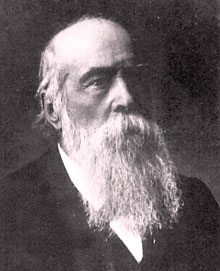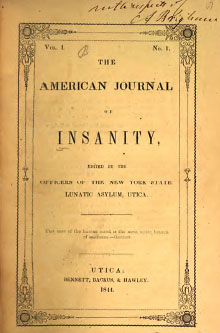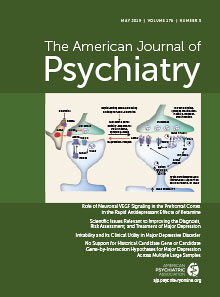AJP Celebrates 175 Years Since Amariah Brigham Published First Edition
Abstract
Over the decades, the American Journal of Psychiatry has published basic, clinical, and public health research on mental illness that has made it the premier peer-reviewed journal in psychiatry.
Amariah Brigham, M.D., may have had no idea what he had given birth to in July 1844 when he published the first edition of The American Journal of Insanity, which would be renamed The American Journal of Psychiatry (AJP) 77 years later.

“In the brain the state of inflammation itself either very quickly ceases or very soon causes death; but when it does cease it leaves behind it consequences which are frequently the causes of insanity, and the conditions of cerebral atrophy.” —Sir John Charles Bucknill (American Journal of Psychiatry, 1857)
Brigham was one of 13 superintendents of America’s asylums for people with mental illness who founded the Association of Medical Superintendents of American Institutions for the Insane in 1844. They needed a way to communicate with each other, and the journal was their solution. (In 1893, the organization changed its name to the American Medico-Psychological Association and again in 1921, when it became the American Psychiatric Association.)
Brigham was superintendent of the New York State Lunatic Asylum in Utica, N.Y., and as recounted in a 1994 article by Nancy Andreasen, M.D., editor of AJP, Brigham published the journal from Utica largely at his own expense. (Andreasen’s article appeared in an editor’s introduction to a supplement celebrating the journal’s 150th anniversary.)
The journal may have been conceived principally as a way for the superintendents to provide an accounting of their census; the first article in the table of contents of that first edition was a “Brief Notice of the New York State Lunatic Asylum, at Utica, and of the Appropriations by the State for the Benefit of the Insane.” It detailed the number of patients (433) admitted since it was opened in 1843, the number who had recovered and who had died, and the number who were current patients—245, of which there were 124 men and 121 women. The journal also had a second article with a table reporting the census of all of the asylums and patients who were “public charge” and “private charge.”
But that first edition also included an essay by Brigham on the subject of whether there should be institutions exclusively for poor and “incurable” patients. Brigham argued against it, saying the poor and very ill should be integrated into institutions that also included wealthier patients and those with a hopeful prognosis.
175 Years of Research and Commentary
Here is a list of the American Journal of Psychiatry issues cited in the article above. APA members who log in with their APA ID can access back issues of the journal at no cost beginning with its first issue in 1844.
“Sesquicentennial Anniversary Supplement. Editor’s Introduction”
“Number of the Insane and Idiotic, With Brief Notices of the Lunatic Asylums in the United States”
“Ventricular Enlargement in Schizophrenia: Relationship to Positive and Negative Symptoms”
“Perinatal Choline Effects on Neonatal Pathophysiology Related to Later Schizophrenia Risk”
“Exercise and the Prevention of Depression: Results of the HUNT Cohort Study”
“Establishments solely for the poor and incurable would, we believe, soon become objects of but little interest to anyone and in which neglect, abuse, and all kinds of misrule would exist, and would exist without observation.”
Thus did Brigham introduce an issue that APA is still addressing today: stigma and discrimination against people with mental illness.
In its 175-year history, the journal has been home to articles that captured an era, such as Brigham’s 1847 essay on “The Moral Treatment of Insanity,” William Menninger’s 1949 article on “The Role of Psychiatry in the World Today,” and John Romano’s 1990 review of the postwar period, “Reminiscences: 1938 and Since.”
The journal also had authors who now appear remarkably prescient. In a 1927 article titled “The Onset of Schizophrenia,” Harry Stack Sullivan, M.D., anticipated the contemporary movement toward early identification and treatment of individuals at risk for psychosis before they become acutely ill. “The psychiatrist sees too many end states and deals professionally with too few of the pre-psychotic,” he wrote. “With this in mind, it would seem as if we should lay great stress on the prompt investigation of failing adjustment, rather than as is so often the case, wait and see what happens.”

Similarly, in 1926 Karl Menninger, M.D., wrote an article titled “Influenza and Schizophrenia,” anticipating the explosion of interest today in the relationship between infection and psychosis. And Franz Kallmann, M.D., wrote about “The Genetic Theory of Schizophrenia” in 1946.
Of course, AJP has been the publisher of research that has transformed patient treatment. In the December 1966 issue, Ralph Wharton, M.D., and Ronald Fieve, M.D., of the New York State Psychiatric Institute reported on the successful use of lithium for 19 patients with manic-depressive psychosis. “There is no question that lithium is a potent drug in its capacity to alter mood in some unusual way,” they wrote.
In the 1970s and 1980s, the first real-time brain images became available in the form of computerized tomography (CT) scans and magnetic resonance imaging (MRI).
Cognitive neuroscience would never be the same.
In the March 1982 issue, Andreasen was lead author of a study using CT images to show an association between ventricular enlargement in people with schizophrenia and negative symptoms. “These findings,” the study concluded, “suggest that combining a measure of brain structure with the clinical picture may provide a useful new approach to the classification of schizophrenia.”
In the contemporary era, research on predisposing risk factors for mental illness and efforts to reduce the risk or even prevent mental illness have taken center stage. In the February 2003 issue, Robert Freedman, M.D., was the lead author of a study showing that perinatal supplementation with dietary choline affects neonatal brain development in a way that may be protective against schizophrenia. Freedman went on to become editor of AJP in 2006.

A measure of a journal’s impact on a field is how often it gets cited in subsequent works as foundational support for pursuing a study hypothesis. The overwhelming majority of the nearly 150 publications in the field of psychiatry average less than one subsequent citation for every article they publish. But in 2018, Clarivate Analytics, which tracks subsequent citations, reported that there were more than 13 citations in 2017 publications for every article AJP published in the preceding two-year period.
Looking ahead, AJP Editor Ned Kalin, M.D., says the challenge is to integrate diverse lines of research—basic, genetic, and neuromolecular research and clinical intervention studies—to elucidate the factors that increase risk for mental illness. “By bringing together findings from these diverse approaches, we can better understand important mechanisms that underlie the onset and maintenance of psychiatric illnesses and also shed light on new treatment approaches,” he told Psychiatric News.
Amariah Brigham might be astonished at the scientific distance that AJP has traveled over the years, but he would be pleased to see that the journal continues to publish research dedicated to the hope he expressed 175 years ago in that essay in the inaugural edition: “Let all have the same kind care and all indulge the same hope … of ultimate recovery.” ■



